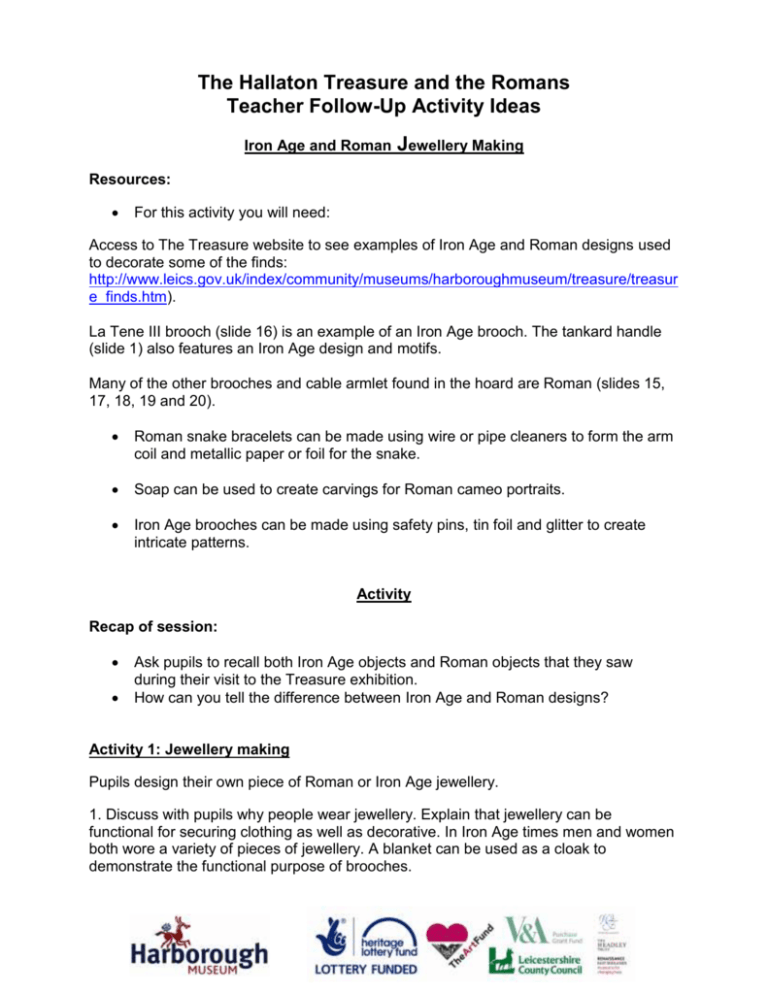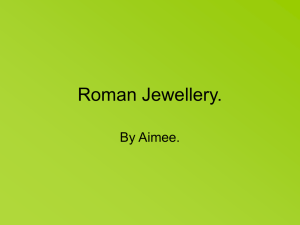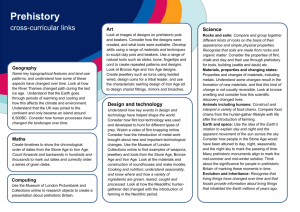Activity 3: Iron Age or Roman
advertisement

The Hallaton Treasure and the Romans Teacher Follow-Up Activity Ideas Iron Age and Roman Jewellery Making Resources: For this activity you will need: Access to The Treasure website to see examples of Iron Age and Roman designs used to decorate some of the finds: http://www.leics.gov.uk/index/community/museums/harboroughmuseum/treasure/treasur e_finds.htm). La Tene III brooch (slide 16) is an example of an Iron Age brooch. The tankard handle (slide 1) also features an Iron Age design and motifs. Many of the other brooches and cable armlet found in the hoard are Roman (slides 15, 17, 18, 19 and 20). Roman snake bracelets can be made using wire or pipe cleaners to form the arm coil and metallic paper or foil for the snake. Soap can be used to create carvings for Roman cameo portraits. Iron Age brooches can be made using safety pins, tin foil and glitter to create intricate patterns. Activity Recap of session: Ask pupils to recall both Iron Age objects and Roman objects that they saw during their visit to the Treasure exhibition. How can you tell the difference between Iron Age and Roman designs? Activity 1: Jewellery making Pupils design their own piece of Roman or Iron Age jewellery. 1. Discuss with pupils why people wear jewellery. Explain that jewellery can be functional for securing clothing as well as decorative. In Iron Age times men and women both wore a variety of pieces of jewellery. A blanket can be used as a cloak to demonstrate the functional purpose of brooches. 2. Use an interactive whiteboard to show pupils the examples of Iron Age and Roman designs featured in the Treasure hoard. Iron Age craftsmen used symmetrical designs and intricate patterns as well as animal shapes such as horses, deer and faces of creatures and people of importance to them. Other examples included a coiling snake symbolized immortality, a wheel represented the sun or movement, stags a represented hunting and lions were a symbol of strength. Cable jewellery was popular amongst the Romans and involved strands of wire twisted together. Roman designs featured animals, horses, hares, birds and fish as well as imagery of gods and goddesses. Some Roman jewellery designs were much simpler than those produced by Iron Age craftsmen, often featuring plain surfaces. The Romans used a wide variety of materials in their jewellery, including gem stones, jet, amber and pearls. They had access to a wealth of natural resources across the European and Mediterranean continents under their rule. 3. Pupils design their own piece of jewellery (i.e. torc, armlet, bracelet or brooch) featuring either Iron Age or Roman designs and patterns. Pupils decorate these with motifs and explain the significance of their designs.







